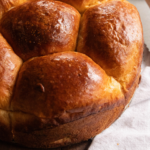Description
This recipe for sourdough brioche is light, tender, and buttery, a long fermented take on the classic French enriched loaf.
Ingredients
For the Tangzhong
- 306 grams (approx. 1 1/4 cup) whole milk
- 68g (1/2 cup) all-purpose flour
For the Sourdough Brioche
- All of the Tangzhong
- 60 grams(1/4 cup/2.1 fl. oz.) whole milk
- 50 grams (1/4 cup) granulated sugar
- 3 large (150 grams) eggs
- 114 grams (1/2 cup) active, bubbling sourdough starter
- 10 grams (1 1/2 teaspoons) fine sea salt
- 439 grams (3 1/4 cups) all-purpose flour
- 142 grams (10 tablespoons) unsalted butter, very soft
Instructions
For the Tangzhong:
In a small saucepan, whisk together the whole milk and flour until the mixture is smooth. Place the pan over medium low heat and cook it, whisking constantly.
Continue to cook and stir until the mixture has thickened to a paste. This should take 5-7 minutes. Remove the tangzhong to a clean bowl and allow it to cool.
For the Sourdough Brioche Dough:
In the bowl of the stand mixer, combine the tangzhong, milk, sugar, eggs, and sourdough starter. Mix them until the eggs are smooth. The mixture may be slightly globulous and not completely smooth. That’s just fine! It’ll all become cohesive when you’ve added the flour.
In a separate bowl, whisk together the flour and salt. Add them to the wet ingredients and mix on medium speed until all of the flour is incorporated.
The dough should be soft and won’t pull away from the sides of the bowl. However, if it’s not holding any shape, add flour a tablespoon at a time until the dough is a soft but workable consistency.
With the mixer still kneading, add the soft butter a tablespoon at a time until it’s all mixed into the dough. Take your time adding it in, allowing each piece to thoroughly mix in before adding more. This process should take 7-10 minutes, so don’t rush! and definitely don’t add all the butter at once, or melt it–the texture of your dough can be ruined.
Once all of the butter is incorporated into the dough, allow the dough to knead on medium speed for another 5 minutes.
The First Rise (aka Bulk Proof)
When the kneading is finished, use a bowl scraper or rubber spatula to remove the dough to the buttered bowl. Cover it with plastic wrap, a bowl cover, or a (wait for it)…. plastic shower cap.
Allow it to rise in a warm, draft-free area for 6-8 hours, or until it’s about doubled in size. Place it in the refrigerator for at least 4 hours, or overnight, to allow the butter to firm up. This makes the dough manageable for the shaping process, which is coming up next.
Shaping the Brioche Into a Loaf
Traditionally, brioche is shaped in a brioche à tête, like this beauty from which translates to head of brioche. But if you don’t happen to have a brioche mold on hand (I don’t), we’re going to make an equally pretty loaf in a loaf pan.
Your final dough weight will be approximately 1250 grams. Turn the dough out onto a lightly floured surface. Divide it into equal halves, then each half into 8 equal portions. You’ll have 16 small portions of about 78 grams each.
Shape each portion into a rough ball, the press it out gently. Fold it in thirds one direction like a letter, then repeat the folds the opposite direction. You should end up with a small ball.
Pinch the undersides of the dough ball together. Cup your hand around the ball and push it along the surface, creating tension on the outside of the dough ball.
Place eight dough balls each into 2 buttered loaf pans, preferably metal ones. You can place them in two even rows, or put them in a staggered pattern. Either way, the finished loaf will be beautiful!
Second Rise
Loosely cover the loaf pan with plastic wrap. Allow the loaf to rise until nearly doubled. It should jiggle slightly if you shake the pan. Brush the top with an egg wash.
Baking the Brioche
Preheat the oven to 400°. Place the bread in the oven and bake for 15 minutes. This gives the yeast an initial boost and helps the loaf to rise beautifully.
Turn the oven down to 375° and continue to bake for another 20-25 minutes, or until the loaf is a deep golden brown. The internal temperature, which can be measured with a probe thermometer, should be between 180° and 200°.
Remove the bread from the oven and let it sit in the pan for 10-15 minutes. Turn it out of the pan onto a cooling rack.
Notes
- It’s worth noting that you won’t see much activity in the loaf for the first couple of hours of the first rise. In fact, I thought my dough wasn’t going to rise at all the first time I made this. But have faith, keep waiting, and that dough will double soon enough.
- There are several ways to shape the brioche, such as hamburger buns or dinner rolls. I’ve detailed how to do that in the blog post.





